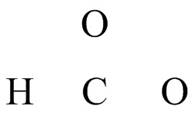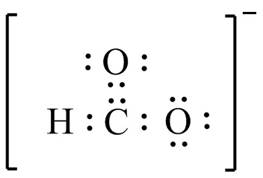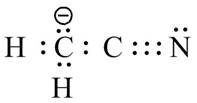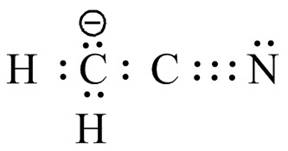
Concept explainers
Draw one valid Lewis structure for each compound. Assume the atoms are arranged as drawn.
(a)
Interpretation: A valid Lewis structure for the given compound is to be drawn.
Concept introduction: The arrangement of valence electrons among the atoms present in a molecule is represented by the Lewis structure of that molecule. The electron pairs in the molecule are considered to be delocalized.
Answer to Problem 1.43P
The valid Lewis structure for the given compound is,

Explanation of Solution
The given compound is
![]()
Figure 1
The valence electrons are counted as,
The bonds and lone pairs are added in the given arrangement of atoms. The valid Lewis structure is,

Figure 2
The valid Lewis structure for the given compound is shown in Figure 2.
(b)
Interpretation: A valid Lewis structure for the given compound is to be drawn.
Concept introduction: The arrangement of valence electrons among the atoms present in a molecule is represented by the Lewis structure of that molecule. The electron pairs in the molecule are considered to be delocalized.
Answer to Problem 1.43P
The valid Lewis structure for the given compound is,

Explanation of Solution
The given compound is

Figure 3
The valence electrons are counted as,
The bonds and lone pairs are added in the given arrangement of atoms. The valid Lewis structure is,

Figure 4
The valid Lewis structure for the given compound is shown in Figure 4.
(c)
Interpretation: A valid Lewis structure for the given compound is to be drawn.
Concept introduction: The arrangement of valence electrons among the atoms present in a molecule is represented by the Lewis structure of that molecule. The electron pairs in the molecule are considered to be delocalized.
Answer to Problem 1.43P
The valid Lewis structure for the given compound is,

Explanation of Solution
The given compound is

Figure 5
The valence electrons are counted as,
The bonds and lone pairs are added in the given arrangement of atoms. The valid Lewis structure is,

Figure 6
The valid Lewis structure for the given compound is shown in Figure 6.
(d)
Interpretation: A valid Lewis structure for the given compound is to be drawn.
Concept introduction: The arrangement of valence electrons among the atoms present in a molecule is represented by the Lewis structure of that molecule. The electron pairs in the molecule are considered to be delocalized.
Answer to Problem 1.43P
The valid Lewis structure for the given compound is,

Explanation of Solution
The given compound is

Figure 7
The valence electrons are counted as,
The bonds and lone pairs are added in the given arrangement of atoms. The valid Lewis structure is,

Figure 8
The valid Lewis structure for the given compound is shown in Figure 8.
(e)
Interpretation: A valid Lewis structure for the given compound is to be drawn.
Concept introduction: The arrangement of valence electrons among the atoms present in a molecule is represented by the Lewis structure of that molecule. The electron pairs in the molecule are considered to be delocalized.
Answer to Problem 1.43P
The valid Lewis structure for the given compound is,

Explanation of Solution
The given compound is

Figure 9
The valence electrons are counted as,
The bonds and lone pairs are added in the given arrangement of atoms. The valid Lewis structure is,

Figure 10
The valid Lewis structure for the given compound is shown in Figure 10.
(f)
Interpretation: A valid Lewis structure for the given compound is to be drawn.
Concept introduction: The arrangement of valence electrons among the atoms present in a molecule is represented by the Lewis structure of that molecule. The electron pairs in the molecule are considered to be delocalized.
Answer to Problem 1.43P
The valid Lewis structure for the given compound is,

Explanation of Solution
The given compound is

Figure 11
The valence electrons are counted as,
The bonds and lone pairs are added in the given arrangement of atoms. The valid Lewis structure is,

Figure 12
The valid Lewis structure for the given compound is shown in Figure 12.
Want to see more full solutions like this?
Chapter 1 Solutions
Organic Chemistry
- Differentiate between plastic deformation, elastic deformation, viscoelastic deformation and viscoplastic deformation.arrow_forward1.57 Draw all reasonable resonance structures for the following cation. Then draw the resonance hybrid.arrow_forwardFor the two questions below, draw the mechanism and form the major product.arrow_forward
- Indicate similarities and differences between natural, exchanged and pillared clays.arrow_forwardShow work. don't give Ai generated solutionarrow_forwardIn intercalation compounds, their sheets can be neutral or have a negative or positive charge, depending on the nature of the incorporated species and its structure. Is this statement correct?arrow_forward
- This thermodynamic cycle describes the formation of an ionic compound MX2 from a metal element M and nonmetal element X in their standard states. What is the lattice enthalpy of MX2 ? What is the enthalpy formation of MX2 ? Suppose both the heat of sublimation of M and the ionization enthalpy of M were smaller. Would MX2 be more stable? Or less? or impossible to tell without more information?arrow_forward7. Draw the mechanism to describe the following transformation: Note: This is a base catalyzed reaction. So, the last steps must make [OH]- OH [OH]¯ OH Heat Oarrow_forwardShow work with explanation...don't give Ai generated solutionarrow_forward
 Living By Chemistry: First Edition TextbookChemistryISBN:9781559539418Author:Angelica StacyPublisher:MAC HIGHER
Living By Chemistry: First Edition TextbookChemistryISBN:9781559539418Author:Angelica StacyPublisher:MAC HIGHER Chemistry: Matter and ChangeChemistryISBN:9780078746376Author:Dinah Zike, Laurel Dingrando, Nicholas Hainen, Cheryl WistromPublisher:Glencoe/McGraw-Hill School Pub Co
Chemistry: Matter and ChangeChemistryISBN:9780078746376Author:Dinah Zike, Laurel Dingrando, Nicholas Hainen, Cheryl WistromPublisher:Glencoe/McGraw-Hill School Pub Co Organic ChemistryChemistryISBN:9781305580350Author:William H. Brown, Brent L. Iverson, Eric Anslyn, Christopher S. FootePublisher:Cengage Learning
Organic ChemistryChemistryISBN:9781305580350Author:William H. Brown, Brent L. Iverson, Eric Anslyn, Christopher S. FootePublisher:Cengage Learning World of Chemistry, 3rd editionChemistryISBN:9781133109655Author:Steven S. Zumdahl, Susan L. Zumdahl, Donald J. DeCostePublisher:Brooks / Cole / Cengage Learning
World of Chemistry, 3rd editionChemistryISBN:9781133109655Author:Steven S. Zumdahl, Susan L. Zumdahl, Donald J. DeCostePublisher:Brooks / Cole / Cengage Learning





